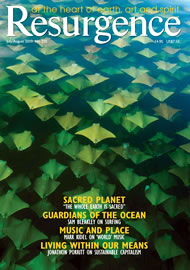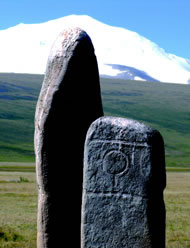The town of Ongudai is the geographical and cultural centre of the Republic of Altai, a small mountainous region in Russia situated near the borders of Mongolia, Kazakhstan and China. In ancient Sanskrit texts Altai was known as the centre point of the Eurasian continent, equidistant from all four of the world’s oceans. The Altai mountains are a unique natural formation with a high degree of biodiversity – it is the habitat of the last snow leopards, Altai mountain sheep and other rare animals and plants, as well as being a cultural crossroads for many peoples. Indigenous Altaians have preserved the rich cultural and historic heritage of their ancestors, who absorbed characteristics of many peoples while preserving their roots as a shamanic culture with a strong nature-centred view of human existence and the Universe. It is here that I met Danil Mamyev, Director of the Uch Enmek Nature Park, which is working to protect sacred sites and teach traditional ecological wisdom to young people in the area. Well versed in the modern education system, Danil also teaches ancient Altaian philosophy, combining scientific approaches with traditional ecological knowledge in his work. He is also Director of a school for contemporary understanding of ancient wisdom, the Tengri Spiritual Ecology School, which works for the protection of culture, Nature and biodiversity in Altai and for all humanity.
How did you become involved in this work, and what is Uch Enmek Nature Park?
I grew up here and in the 1990s I began to work on creating a Nature park to protect the Karakol Valley and Mount Uch Enmek, which Altaians have believed since ancient times are sacred places. In 2001, as part of an initiative by the Tengri Spiritual Ecology School, a protected area called Karakol Nature Park Uch Enmek was established. It provides a model in the region for the harmonious and mutually complementary development of modern society and Indigenous cultures, with park management respecting the traditional principles and ethno-ecological consciousness of the Indigenous population. Here the sacred sites are revered by different spiritual traditions inherited from their ancestors. Sacred sites have been protected for centuries – indeed, millennia – and serve as the basis of a caring and spiritual relationship with Nature.
The spiritual and religious beliefs and values of the ethnic Altaian people and the Altaian Kazakhs contain a strong conservation ethic and they hold these locations, geographical features and water bodies to be sacred. The local population has accumulated important knowledge about the laws of mountain Nature and how to connect with the elements and energies of the place. It took many generations to learn to live sustainably in Nature and to develop rules and morals, as well as taboos, connected to natural occurrences and to the richness of the animal and plant worlds. For example, there is an entire body of rules and taboos connected to natural springs believed to have healing properties.
Sacred sites are distinguished by their strong natural energetic properties. In their own way, they are the acupuncture points of the planetary organism, through which all energy channels, helping to keep the ecological condition of the world’s biodiversity intact. Each sacred place has its own function within the planetary organism. Knowing the properties of these lands, Indigenous cultures have developed specific norms for behaviour and activities over the course of many generations.
Protection of sacred sites is very important, as is human interaction at each site. When visiting sacred sites, one receives knowledge from these places and leaves one’s own, so it is important to embark on such pilgrimages with pure intentions. Defilement of sacred sites results in negative impacts for the defiler. In the mountains the ‘boomerang effect’ operates as nowhere else, and the payoff equals that which was given! The spiritual value of these places was recognised by people thousands of years ago, much earlier than the rise of the modern conservation movement.
In the face of global warming and catastrophic losses in biodiversity, is it possible to save Altai and humanity from collapse?
The main reason for all of these cataclysms is spiritual degradation and consumerism. Modern industrial society has reached a critical level in its development, a level at which further progress is becoming unviable without changes to its spiritual mentality. In order to ensure the correct use of modern achievements in science and technology, society must incorporate the knowledge and experiences of Indigenous peoples that is preserved in their distinctive traditional culture.
The spiritual and ecological wisdom of Indigenous peoples has been passed on over many generations: natural laws, rules for human behaviour on planet Earth, the influence of human thought on the surrounding environment, and the importance of human interrelations. This knowledge is conveyed from generation to generation, like an algorithm of natural interactions. At last it seems that the wider society is ready to listen to Indigenous peoples and accept the fact that they are carriers of essential and reliable knowledge for the establishment of conditions for human development based on the conservation of natural and cultural biodiversity. Diversity in the plant and animal world in Altai predetermines diversity of human understanding of the world. This diversity cannot exist on the basis of mutual exclusion, but only on the basis of mutual complementarity. New things arise on the basis of the vital functions of existing life and its diverse expressions.
These days, we use our natural resources sacrilegiously. Digging, draining, cutting, we don’t even suspect that the ores, oil and wood serve a variety of functions within the general planetary organism. We must acknowledge that, in order to make use of Altai’s natural energy potential – such as its gas reserves – it will be necessary to devote serious attention to the wisdom of the Indigenous population, who must help to balance this extraction with their ritual and prayers.
Today, there are five parks like Uch Enmek Nature Park in the Republic of Altai, and protected areas constitute more than 23% of the entire Republic’s land area. This is a positive and optimistic indicator for the preservation of the region’s cultural and natural heritage. There is indeed hope of preventing global calamity. •
English translation by Jennifer Castner.
Chagat Almashev is Director of the NGO Foundation for the Sustainable Development of Altai.









